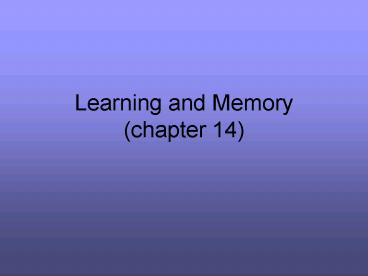Learning and Memory chapter 14 PowerPoint PPT Presentation
1 / 23
Title: Learning and Memory chapter 14
1
Learning and Memory (chapter 14)
2
Learning and Memory
- Memory refers to the storage and retrieval of
information. - No absolute boundaries between learning and
memory. - Learning and memory may be viewed as a continuum.
3
Early Theories of Memory Storage
- 1915-1950-Engram (Lashley)
- 1950s to present- Short and Long Term Systems
- Hebbs cell assemblies
4
Locating the Engram
- Karl Lashley observed the effects of lesions on
rats maze learning. - The larger the amount of cortex damaged, the more
errors the rats made.
- Lashley believed that the engram was distributed
across the cortex.
5
Memory Processing
- Short-term Memory (STM)
- Limited capacity (7 items)
- Brief duration
- Can be lost without rehearsal
- Long-term Memory (LTM) permanent storage
- Consolidation Process by which rehearsal of
information in STM results in transfer to LTM
6
Unusual Memory Phenomena
KHBS KHOG/AP/Wide World
- Stress enhances
- memory via actions on
- amygdala and
- hippocampus
7
Divisions of Long-term Memory
8
Reinforcement
- Learning provides a means for us to profit from
experience-to make responses that provide
favorable outcomes. When good things happen,
reinforcement mechanisms in the brain become
active, and the establishment of synaptic changes
is facilitated. Where in brain does this happen?
9
The Critical Hippocampus
- Important for memory consolidation
- Storage of implicit memory
10
In addition to the hippocampal formation, where
are memories stored?
- Inferotemproal cortex an area of secondary
sensory cortex--long-term visual memory - Amygdala emotional significance--lesions impair
fear conditioning - Prefrontal cortex damage impairs memory for
temporal order of events and working memory - Cerebellum and striatum implicit memory of
sensorimotor learning
11
Amnesia
- Amnesia refers to a failure to remember
- Anterograde amnesia involves a difficulty in
forming new memories for events that occur after
a brain trauma - Anterograde amnesia involves a disorder of
relational learning - Anterograde amnesia involves a difficulty in
learning new material - Retrograde amnesia is an inability to recall
events that occured prior to the trauma - Amnesia can be temporary or permanent
12
Types of Amnesia
13
Hippocampal Damage and Amnesia
- Severe anterograde amnesia follows bilateral
damage to the hippocampus - Patient H.M. suffered from severe epilepsy
- To minimize his epilepsy, H.M.s surgeons removed
his medial temporal lobe (including the
hippocampus) - Following surgery, H.M. showed severe anterograde
amnesia - No retention for events that have occurred since
1953 - Can recall events that occurred prior to 1953
- H.M.s amnesia was attributed to hippocampal
damage
14
Patient H.M. and Memory
- Large areas of H.M.s temporal lobes were
surgically removed. - H.M.s personality and IQ were not affected.
- H.M. experienced profound anterograde amnesia.
Courtesy Dr. Suzanne Corkin, Massachusetts
Institute of Technology
15
H.M.s Memories Are Not Equally Affected
- Short-term memory allowed H.M. to converse.
- H.M. retained the ability to learn procedural
tasks. - H.M.s deficits appear in explicit memory tasks.
16
The Diencephalon and Memory Patient N.A.
- A fencing foil produced a lesion to N.A.s left
dorsomedial thalamus. - N.A. experienced profound anterograde amnesia and
some retrograde amnesia. - N.A.s memory loss was similar to H. M.s.
Courtesy L.R. Squire, University of California
San Diego
17
The Diencephalon and Memory
- Korsakoffs patients show anterograde and
retrograde amnesia. - Thiamine deficiencies result from chronic
alcoholism. - Untreated thiamine deficiencies damage
dorsomedial thalamus and mamillary bodies. - Monkeys with lesions in the dorsomedial thalamus
or mamillary bodies have difficulties with the
DNMS test. - Temporal-diencephalic circuits may process
long-term memories.
18
Memory and Normal Aging
- In healthy adults, most measures of cognitive
ability remain stable. - Memory loss may accompany changes in brain
systems that utilize the neurotransmitter
acetylcholine (ACh). - Attaining an above-average education engaging in
complex, non-routine professions and earning
high income appear to protect against cognitive
decline.
19
Other Forms of Amnesia
- Alzheimers Disease (basal forebrain)
- Concussion (PTA)
- Electroconvulsive shock (ECS)
20
Implicit Memory Reflexive GillWithdrawal in
Aplysia
- Sensitization
- Habituation
21
The Anatomy of the Hippocampus
22
LTP and the NMDA Receptor
23
The Hippocampus and Human Memory
- The right hippocampus is active during spatial
memory processing and the left hippocampus is
active during verbal memory processing. - Rostral portions of the hippocampus are more
active during encoding, and caudal portions are
active during retrieval. - The hippocampus does not store memories, but
transfers them from short to long-term storage.

